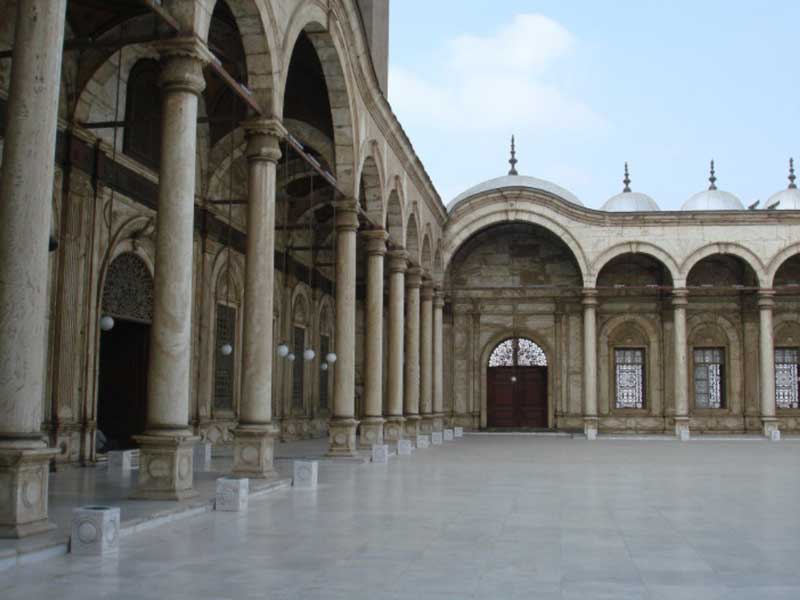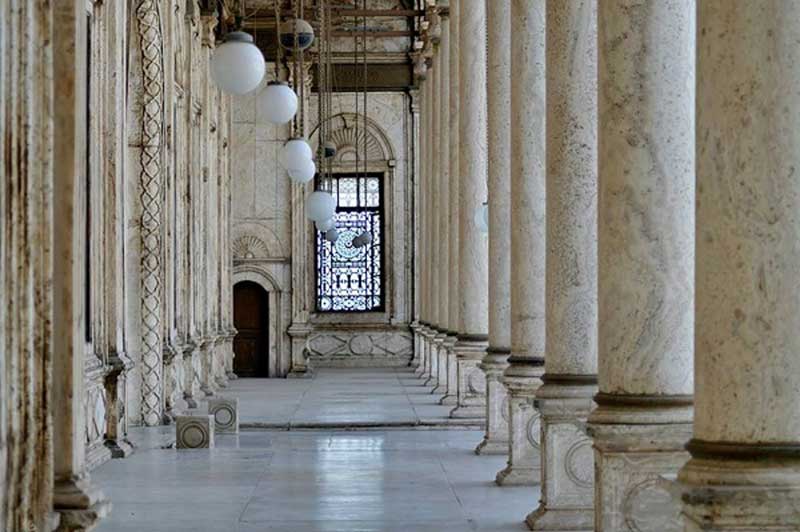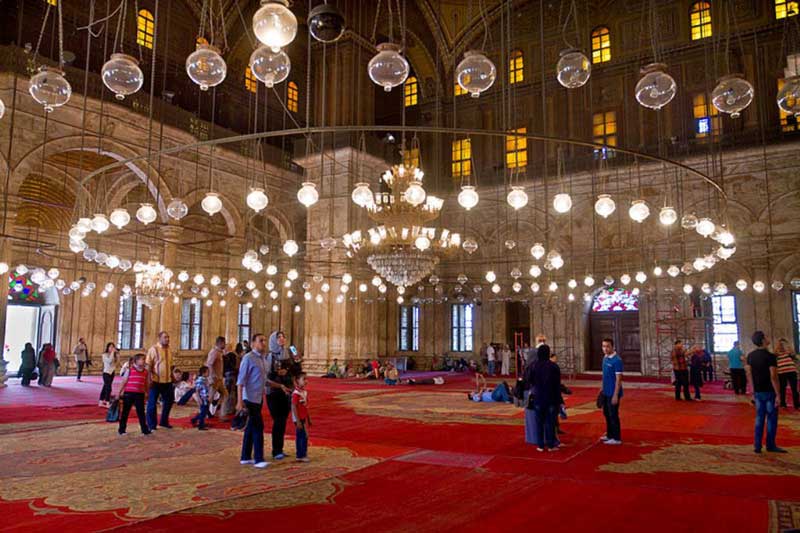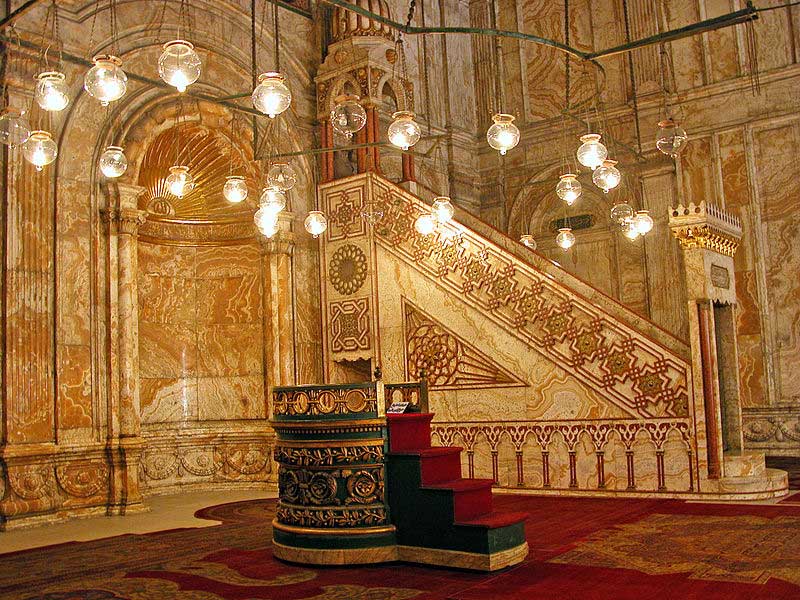
Towers above Cairo, the capital city of Egypt, from the summit of the Citadel, the Mosque of Muhammad Ali Pasha, also known as the Alabaster Mosque, was commissioned by Muhammad Ali Pasha between 1830 and 1848, in memory of his eldest son, Tusun Pasha, who died of plague in 1816.
The citadel is a medieval Islamic fortification that served as the seat of the Egyptian government for around 700 years from the 13th-century onwards and is today recognized as a UNESCO World Heritage Site, while Muhammad Ali Pasha was the Ottoman governor, who became the de facto ruler of Egypt from 1805 to 1848, eventually rebelled against the Ottoman Sultan, and is known as the founder of modern Egypt. With its great dome, the twin towering minarets, and the romantic oriental look, the mosque is one of the landmarks of Cairo and is one of the first structures that one can see while approaching the city from any direction.

To make space for the new mosque, the remains of the dilapidated Mamluk buildings in the citadel were cleared at the instruction of the Pasha, which were described a short time earlier by some scholars as very impressive despite their ramshackle condition.
However, apart from making space for the new structure, it also served the purpose of eradicating the legacy of the earlier Mamluk Sultanate in the area. Actually, just as many centuries earlier Salah al-Din had erased all traces of the Fatimid political and religious dynasty from Egypt, Muhammad Ali Pasha destroyed all the buildings and palaces of the Mamluk Sultanates, who ruled the country since the thirteenth century.

Initially, the French architect Pascal Coste was assigned to construct the proposed building of the mosque, who probably would have built it in the typical Mamluk style, as he had a fascination for the traditional architecture of Cairo.
However, Muhammad Ali had other things in his mind. He wanted to design his dreamed mosque on a plan similar to that of the Sultan Ahmed Mosque in Istanbul, popularly known as the Blue Mosque and hired the Greek architect Yusuf Boshnak from Istanbul for the purpose. Muhammad Ali purposely wanted to replicate the design of the famous mosque of Istanbul as a symbol of his defiance of the Ottoman Sultan and indicating his intention to create Cairo as a strong rival of Istanbul. Ironically, despite the significant intention to defy the supremacy of the Ottoman Sultanate and the declaration of Egyptian independence, the Muhammad Ali Pasha Mosque in Cairo is a unique example of the Ottoman architectural style. However, it took long eighteen years to complete the construction of the mosque in 1848, although it got its final shape during the reign of Mohamed Said Pasha in 1857, when the body of Muhammad Ali was shifted here from Hosh al-Basha, the mausoleum of the Royal Family, and was buried in a tomb carved from Carrara marble in the courtyard of the mosque.

The facades of the Muhammad Ali Pasha Mosque in Cairo are angular and severe and rise about four storeys until the level of the lead-covered domes. While mainly made of limestone, the lower storey and forecourt is tiled with alabaster, a very fine-grained white or a lightly tinted variety of gypsum or calcite, up to 37 feet (11.3 m). Constructed in a square plan measuring 135X135 feet (41x41 m), the mosque was built with a central dome, 68 feet and 10 inches (21 m) in diameter, and more than 170 feet (51 m) high, surrounded by four smaller domes and four more lead-covered semicircular domes. The mosque has two graceful, cylindrical, and unusually tall minarets on its western side, soaring 275 feet (83.8 m) into the sky and equipped with two balconies and conical caps.

The courtyard of the mosque is surrounded by columned arcades, and there is a clock tower in the middle of the northwestern arcade. The clock of the tower was gifted by King Louis Philippi I of France to Muhammad Ali Pasha, in reciprocation of Pasha’s gift of the Luxor obelisk to the king, which was later installed in the famous Place de la Concorde in Paris. Unfortunately, the clock arrived damaged and has never been repaired. The traditional ablution fountain, octagonal in shape, stands in the middle of the courtyard, with an elaborately carved wooden roof topped by a leaded dome. Although there are three entrances on each side of the forecourt, the northeastern gate serves as the main entrance to it. The white marble tomb of Muhammad Ali Pasha, adorned with floral motifs, is located in the courtyard, just right of the main entrance.

The interior of the Muhammad Ali Pasha Mosque, covering a huge area of 440 square feet (40.87 sq m), creates the impression of an incredible space, enhanced by the domes, set into the ceiling, and the central dome rising on four arches standing on the colossal piers. The central dome is adorned with six medallions, bearing the Arabic names of Allah, the Prophet Muhammad, and the first four caliphs. The ceiling, with its decorative paintings, inlays, and gilded accents, seems to reflect the light emanating from the enormous circular chandelier, which itself serves as a wonderful piece of decoration. The grandeur of the huge area is additionally enhanced by the circle of small lamps hung in the middle of the praying area, just below the main dome of the mosque.

Unlike other mosques, the Muhammad Ali Pasha Mosque has two minbars or pulpits. While the original minbar, made of gilded wood, is said to be one of the largest in Egypt, the marble made second one was added much later, gifted by King Farouk, one of the descendants of Muhammad Ali, in 1939.

As the building of the mosque was indicating dangerous structural deterioration, a detailed scheme of restoration was ordered by King Fuad in 1931, which was finally completed in 1939 by King Farouk.